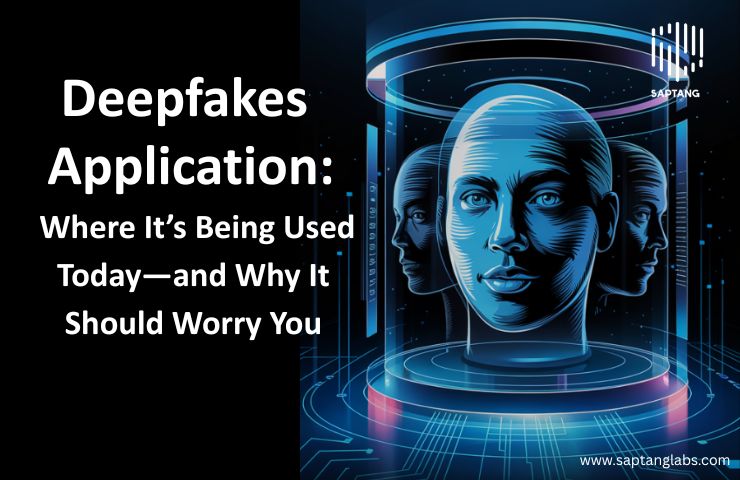Introduction
Deepfakes application used to be something you’d hear about in tech blogs or sci-fi shows. Not anymore. Today, they’re quietly creeping into everyday life—on social media, in marketing, in politics, and even in cybercrime. Powered by artificial intelligence, deepfakes can create shockingly realistic fake videos, photos, or audio that can be nearly impossible to tell apart from the real thing.
In this article, I’ll break down where deepfakes are actually being used today and, more importantly, why their growing presence is a serious concern—especially when it comes to trust, safety, and security.
What is Deepfakes Application?
At its core, a deepfake is media—usually a video or audio recording—that’s been digitally altered using deep learning techniques. With enough training data (images, voice samples, video footage), AI can recreate a person’s face, voice, or expressions and make them say or do things they never actually did.
Not all deepfakes are harmful. Some are used for entertainment or artistic purposes. But the line between harmless and harmful is blurring fast—and that’s what makes them dangerous.
Real-World Applications of Deepfakes
Let’s take a look at how deepfakes are already being used in the real world. You might be surprised at how mainstream this has become.
1. Entertainment & Film
Hollywood has embraced deepfake tech to a certain extent. Remember the younger version of Luke Skywalker in The Mandalorian? That was deepfake tech. Filmmakers are now using it to de-age actors, create digital doubles, or even bring back actors who have passed away.
This kind of use is heavily controlled and often done with permission. But it opens the door to how easily a face—or a voice—can be digitally replicated.
2. Social Media & Content Creation
Apps that let you swap faces with celebrities or animate old photos have made deepfakes fun and viral. You’ve probably seen someone lip-syncing in a vintage black-and-white video, or a politician “dancing” to a pop song.
It seems like harmless fun, but it normalizes a technology that can be used to deceive at a much larger scale.
3. Corporate & Marketing Use
Some brands are experimenting with deepfakes to create lifelike virtual influencers or generate personalized ads. There are even AI-generated customer service avatars that can “speak” in multiple languages and mimic human emotions.
While innovative, these uses raise questions about consent, transparency, and the line between real and synthetic communication.
4. Politics & Propaganda
This is where things get dangerous. There have already been fake videos of politicians appearing to say or do outrageous things. Even if they’re proven false later, the damage is often done.
A convincing deepfake can mislead voters, spread disinformation, or trigger political unrest—all within hours.
5. Cybersecurity Threats
From a cybersecurity standpoint, deepfakes are a growing nightmare. We’ve seen cases where scammers used deepfake audio to impersonate a CEO’s voice and trick employees into transferring large sums of money. This tactic, called “voice phishing” or “vishing,” is only becoming more sophisticated.
In the wrong hands, deepfakes can be used to launch social engineering attacks, impersonate company executives, or create fake “evidence” in fraud cases.
Why It Should Worry You
You might think, “This doesn’t affect me.” But here’s why deepfakes should be on everyone’s radar.
1. You Can’t Trust What You See Anymore
We’ve always relied on video as proof—whether it’s CCTV footage, a speech, or a recorded confession. Deepfakes challenge that idea. If anything can be faked, what can we trust?
2. Disinformation Can Spread Like Wildfire
A fake video shared online can go viral in minutes. Even if it’s debunked later, many people may have already seen and believed it. This can influence elections, spark protests, or damage reputations beyond repair.
3. Cybercrime Just Got Smarter
Deepfakes application is being used in phishing and fraud. If someone can fake your voice or face, they can impersonate you online. This creates a new layer of risk for businesses and individuals alike.
4. Personal Privacy Is at Risk
There have been growing cases of deepfake pornography—usually targeting women—made without consent. The psychological harm and reputational damage can be severe, and the legal framework is still catching up.
What’s Being Done About It?
Governments and tech platforms are beginning to take the threat seriously.
- Tech companies like Meta and Google are developing detection tools.
- Legislation is slowly being introduced in countries like the U.S., UK, and EU to criminalize malicious use.
- Platforms such as YouTube and TikTok have policies for labeling or removing deepfake content.
But let’s be honest—deepfake detection is always playing catch-up. It’s easier to create a deepfake than to prove one is fake.
Conclusion
Deepfakes application is no longer just an experimental tech curiosity. They’re here, they’re evolving fast, and they’re already being used in ways that affect politics, businesses, and personal lives. As a cybersecurity consultant, I’ve seen firsthand how even a short clip can be enough to trigger panic, confusion, or worse.
The bottom line? We need to be more skeptical of what we see and hear online. Awareness is the first step toward protecting ourselves—and the truth.
You may also like to read this: Intrusion Prevention Service for 2025: What to Look For


